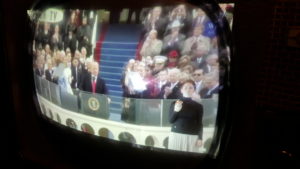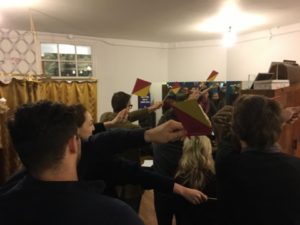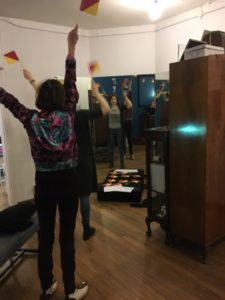
This weekend we held our group show, we being Cate Field, Hilary Champion and myself. As part of our MA it was vital that we pulled our work together to look at it conceptually, aesthetically and in terms of a space that we could use.
During our search for a space we were invited to visit a small dressmaking studio and basement in Bloomsbury, London. The owner wants to expand the use of the space and could offer us a great rate. It turned out to be suited not only to our size, but to the nature of our current work.
Cate took over the basement, her work being a large projection focusing on some topics on the edges of society, homelessness, addiction and old age. Being in the cold, damp unlined basement provided an environmental wraparound to her work. Something that has been missing in a previous showing of the work.
Hilary’s advertisements, posters and statements from the ‘Office of Global Improvement’ sat in the Windows, on shelves, on walls and on the furniture within the studio/shop space. The informality of the space and her work invited a more discursive look at the work more than a white wall hang would have done.


For my own work I chose to use the spaces in the studio that invited both privacy and display. I chose to place my semaphore flags and codes in front of the mirrored corner usually used for dressing/fitting clothes. This mirror invited the audience to look at themselves alongside the work. The mirror along with the flash a don code added an invitation to try the flags out and watch the movements. I extended this by inviting a participatory performance in front of the mirrors. The audience at the private view were invited to each have a set of flags, to face the mirror, and to ‘follow’ me. Like an aerobic instructor I made large slow movements that the audience could follow. I produced these over a series of minutes speeding up as we went. Again the informality of the space invited discussion. So afterwards the audience wanted to know what we had been spelling out and it instigated discussion of the visual usefulness of semaphore and the control I had in producing the group message. The word we spelled in semaphore was Hysteria, the word I am currently using. This word began trough my interest in women and mental health. Starting with Hippocrates invention of the word to mean ‘wandering womb’ and through the centuries that have followed in which the word has referred to many ailments belonging to ‘women’ often with a means to reduce any behaviour or illness to a label of inferiority. It has also been used more recently to describe any behaviours that seem ‘irrational’. Historically this word is huge.
Alongside this I have been producing work using Trump’s inauguration and the ‘hysteria’ (social and political) that has accompanied this period in the western world/media. For the translation titled ‘The Power of the Translator’ I decided to use a TV that fitted the space. As a vintage dress shop the furniture within it is all 1940s and 1950s. I was able to find a 1950s TV set and use this to project the work onto the screen (as the TV was not working). I place the TV and projector together in the changing room of the space. Behind the curtain, hidden and screened slightly from the rest of the space. Th voice of Donald Trump – recognisable to many now- bombing from behind the curtain. In the corner of the screen a figure stands ready to interpret. The figure begins an interpretation of the speech, using sign language and looking like interpreters do when they are seen on accessible films or programmes. The interpreter then stops using sign language and reaches to the floor. She picks something up and starts biting it. It’s an apple. She eats the apple, then puts it down. She then picks up a potatoe and begins peeling it. Then she picks up another and repeats this.
The audience responded with ‘ she isn’t doing anything….’, ‘it looks like she is peeling her own hand’, ‘it looks like she is standing to attention at the speech’.